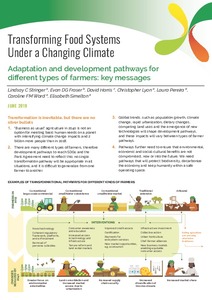One of the greatest challenges humanity faces is feeding the world’s human population in a sustainable, nutritious, equitable and ethical way under a changing climate. Urgent transformations are needed that allow farmers to adapt and develop while also being climate resilient and contributing minimal emissions. This paper identifies several illustrative adaptation and development pathways, recognising the variety of starting points of different types of farmers and the ways their activities intersect with global trends, such as population growth, climate change, rapid urbanisation dietary changes, competing land uses and the emergence of new technologies. The feasibility of some pathways depends on factors such as farm size and land consolidation. For other pathways, particular infrastructure, technology, access to credit and market access or collective action are required. The most viable pathway for some farmers may be to exit agriculture altogether, which itself requires careful management and planning. While technology offers hope and opportunity, as a disruptor, it also risks maladaptations and can create trade-offs and exacerbate inequalities, especially in the context of an uncertain future. For both the Sustainable Development Goals and the 2015 Paris Agreement to be achieved, a mix of levers that combine policy, technology, education and awareness-raising, dietary shifts and financial/economic mechanisms is required, attending to multiple time dimensions, to assist farmers along different pathways. Vulnerable groups such as women and the youth must not be left behind. Overall, strong good governance is needed at multiple levels, combining top-down and bottom-up processes.

